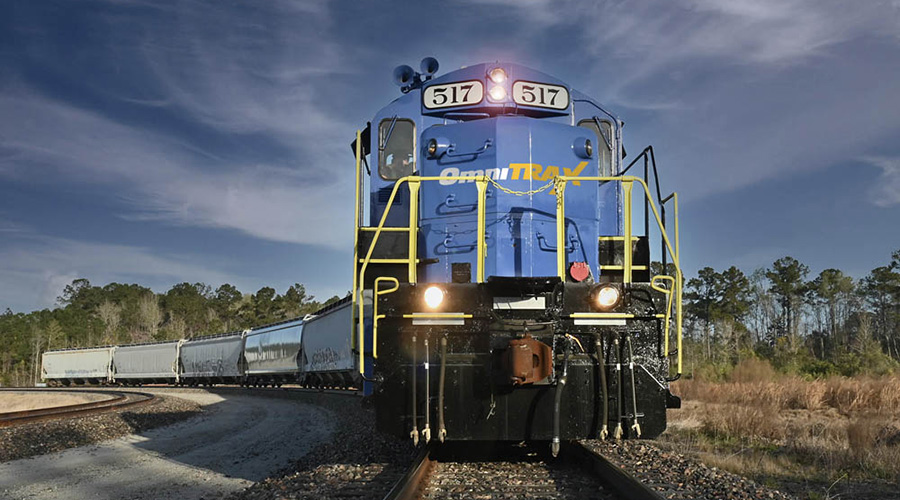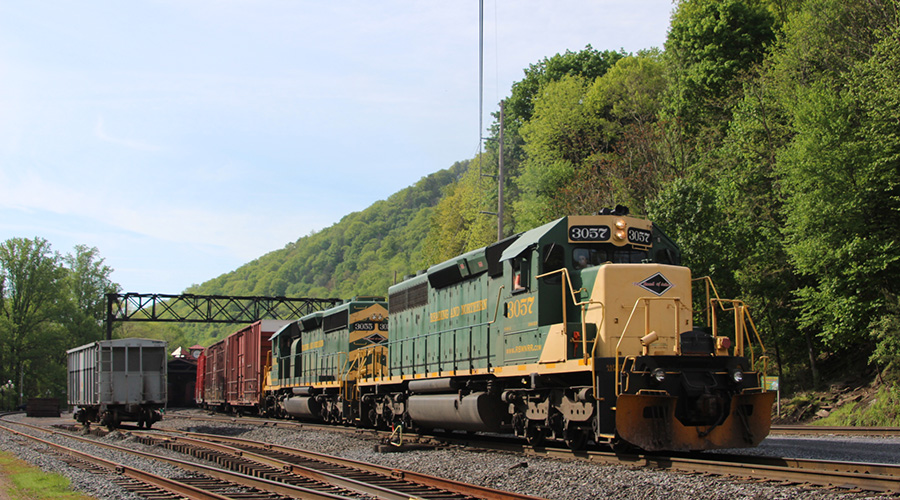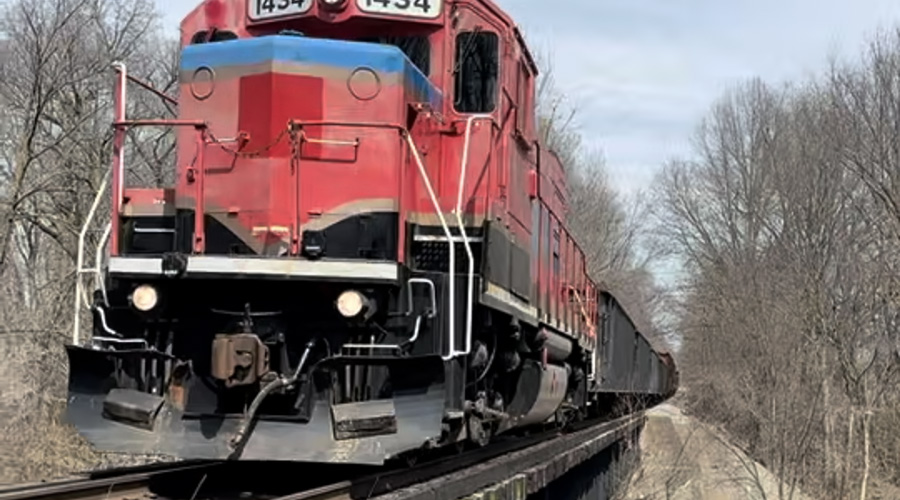Traffic in Q1: Mostly tough sledding for short lines
4/17/2024
By Jeff Stagl, Managing Editor
Many short lines and regionals got off to a rough start traffic-wise in 2024. Data provided by Wabtec Corp.’s GE Transportation arm shows carloads collectively were weak for small railroads in the first quarter.
Through March 30, 460 regionals and short lines registered 1,560,080 carloads, down 3.8% compared with the 1,621,045 units logged in Q1 2023, according to GE’s RailConnect Index of Short Line Traffic.
They posted gains in only three of 14 commodity groups: intermodal (up 9.9% to 240,762 units), ores (up 3.3% to 43,901 units), and motor vehicles and equipment (up 2.4% to 48,410 units).
The biggest decliners on a year-over-year basis — as in double-digit percentage drops — were coal, which plummeted 30.3% to 57,528 units, and farm and food products excluding grain, which tumbled 12.5% to 73,304 units.
“Other carloads” fell 7.7% to 24,839 units; grain carloads declined 7.4% to 183,276 units; paper product loads dipped 6.8% to 78,839 units; and stone, clay and aggregates traffic dropped 6.5% to 161,438 units. The index also shows carloads of lumber and forest products, waste/scrap materials and chemicals all decreased by about 3%, while metals/products traffic was down only slightly.
 So far this year, RBMN’s frac sand volume is way down due to low gas prices, but the regional’s anthracite coal business is way up because of healthy demand. Reading, Blue Mountain and Northern Railroad Co.
So far this year, RBMN’s frac sand volume is way down due to low gas prices, but the regional’s anthracite coal business is way up because of healthy demand. Reading, Blue Mountain and Northern Railroad Co.To gauge how traffic fared for various short-line industry constituents in Q1, RailPrime reached out to a cross-section of them. Following are comments and information provided via email by 10 regionals, short lines or holding companies.
The traffic fortunes of two short-line holding companies reflected the RailConnect Index. Volume for Genesee & Wyoming North America — which owns more than 100 small railroads in Canada and the United States — was in line with the rest of the industry, company officials said.
For OmniTRAX Inc., volume was down slightly year over year primarily because of weak energy products traffic. The company owns and operates 26 regionals and short lines.
“Excluding energy, volumes were up across all other commodity groups in the mid-single digits, led by grain and construction materials,” OmniTRAX officials said. “Energy is expected to rebound over the balance of the year.”
Q1 traffic was slightly better for Watco, coming in flat. The difference in year-over-year carload totals? A scant 26 carloads, said officials at Watco, which owns 44 regionals and short lines in the United States and Canada.
“The main reasons for the Q1 flatness: strong movements in coal and agricultural/food products, but slow movements of fertilizer and some agriculture carloads in the upper Midwest,” they said.
However, Watco officials are encouraged by March volume, which rose 9.8% from February’s level and 3.9% from March 2023’s mark.
 Carloads climbed 17% in Q1 for the North Dakota regional mostly because strong export corn shipments meant more grain shuttles moved to the Pacific Northwest. Red River Valley & Western Railroad
Carloads climbed 17% in Q1 for the North Dakota regional mostly because strong export corn shipments meant more grain shuttles moved to the Pacific Northwest. Red River Valley & Western RailroadTotal traffic was down 1.5% in Q1 for Gulf & Ohio Railways Inc. But there was a significant variation in carloads at the holding company’s four short lines, said Peter “Doc” Claussen Jr., Gulf & Ohio’s vice president.
“One was up 22%, largely due to a significant increase in road salt shipments after a Snowmageddon [during winter]. Butane, plastic and scrap paper are down on that one,” he said. “One was flat and the third one was down 25% due to a temporary shutdown at one customer. The last one was down 14% due to a drop off in biodiesel.”
The Paducah & Louisville Railway Inc.’s (PAL) Q1 traffic dipped 3% to 34,349 units due to double-digit drops in carloads of petroleum products, aggregates, automotives, food products and grain. The quarterly decline would have been worse if stone, clay and glass product traffic hadn’t shot up 43%, including gains from newer limestone customers. In addition, paper, lumber, coal and chemical traffic rose.
“A main driver was coal, mainly due to Class I service and weather improvements from last year,” said PAL Vice President and Marketing and Sales Kevin McEwan.“Petroleum coke shipments fell off the first of this year, but hopefully will be rebounding throughout the year."
For the Reading, Blue Mountain and Northern Railroad Co. (RBMN), traffic has been similarly mixed. So far in 2024, frac sand volume is way down due to low gas prices and salt volume is down due to more mild weather, but anthracite coal business is way up.
As a result, RBMN’s Q1 carloads were basically flat compared with last year’s record-breaking levels and revenues are up due to traffic mix, said RBMN President Wayne Michel. In Pennsylvania, the regional operates more than 400 miles of track from Reading to Mehoopany, as well as a seven-mile line from Towanda to Monroeton.
“Given what we see on gas prices for the foreseeable future we expect a significant decline in our frac sand volume versus 2023,” Michel said. “Given demand for Pennsylvania anthracite internationally as well as for domestic EAF steel mills, we anticipate double-digit growth in coal, which is our largest commodity area (slightly above 30%).”
The railroad’s merchandise business — which accounts for over half of its overall business — appears to be holding pace with last year’s activity. Depending on the timing of certain industrial development projects, merchandise business could tip up by year end, Michel said.
 Due to increased intermediate traffic in Q1, Indiana Harbor Belt’s carloads rose 2% on a year-over-year basis. Indiana Harbor Belt Railroad Co.
Due to increased intermediate traffic in Q1, Indiana Harbor Belt’s carloads rose 2% on a year-over-year basis. Indiana Harbor Belt Railroad Co.At the Indiana Harbor Belt Railroad Co. (IHB), a tick-up in traffic already occurred in Q1. Carloads rose 2% year over year.
The largest U.S. switching carrier, IHB operates 54 miles of mainline track and 266 miles of additional yard and siding track in the Chicago area.
“Our intermediate traffic was strong for the quarter,” said IHB General Manager John Wright.
“Strong” is an apt word to describe the Red River Valley & Western Railroad’s (RRVW) traffic in the quarter. Carloads shot up 17% for the regional, which operates more than 500 miles of track primarily in the southeast quarter of North Dakota.
Volume growth was driven by an increase in the number of grain shuttles heading to the Pacific Northwest due to steady export demand for corn, said RRVW President Victor Meyers.
“The remainder of our business has remained fairly flat when compared to Q1 of 2023,” he said. “Export demand for grain was incredibly soft in 2023, and we did forecast a year-over-year increase in grain exports, but export demand for grain year to date has outpaced our 2024 forecast.”
Although a year-over-year comparison for Seminole Gulf Railway isn’t apples to apples since Hurricane Ian-damaged infrastructure hampered traffic in 2023, the short line’s carloads skyrocketed 73% in Q1.
In September 2022, the Category 5 hurricane severely crippled a lot of track and several bridges along the short line, which runs more than 100 miles between North Naples and Arcadia, and Oneco and Sarasota, Florida. Some of the repairs were just completed recently.
This year, aggregates are driving business, followed by building materials such as drywall and plywood, said Seminole Gulf Railway Executive Vice President Robert Fay.
“Cement production is the primary driver behind the aggregates increase, followed by a Florida DOT project for the Sanibel Island causeway rebuild/strengthening post-hurricane destruction,” he said. “Aggregates being the driver, revenue was up only 50% against the 73% carload increase.”
Similar to others, the traffic news wasn’t great, but wasn’t that bad, either, for Northern Lines Railway (NLR). Owned by Anacostia Rail Holdings, the short line registered flat carloads in Q1. NLR operates 25 miles of track in central Minnesota, interchanges with BNSF Railway Co. and handles more than 10,000 carloads annually.
“Our traffic reflected our usual patterns and volume. No real surprises,” said Quentin Schulte, who recently was promoted from general manager to president at NLR.


